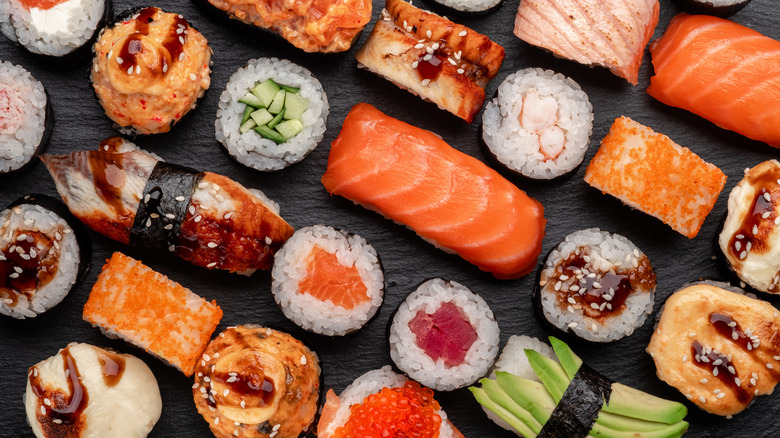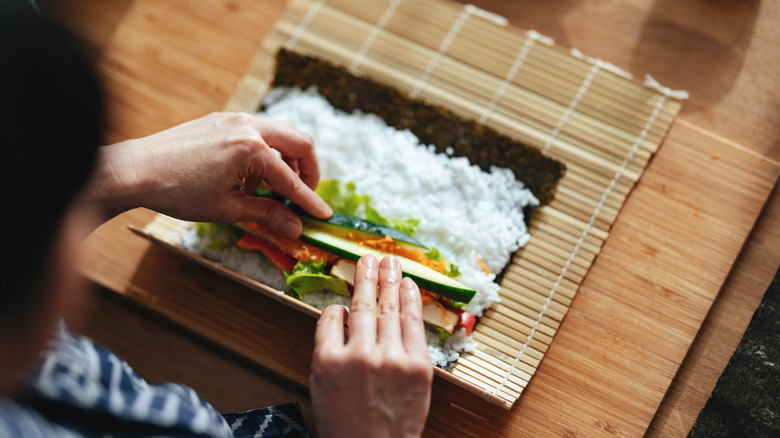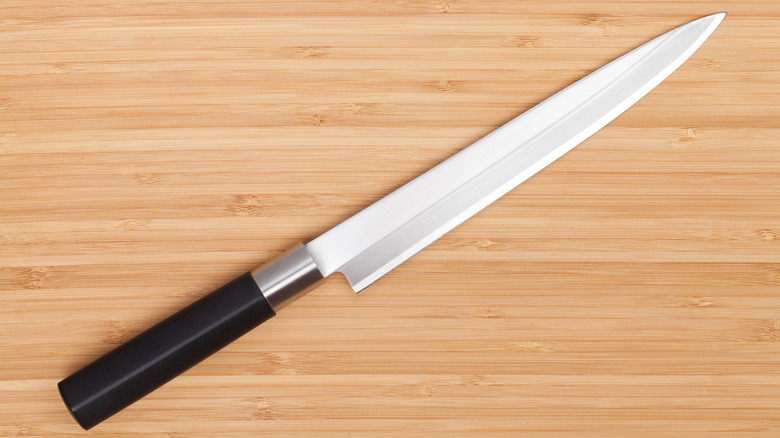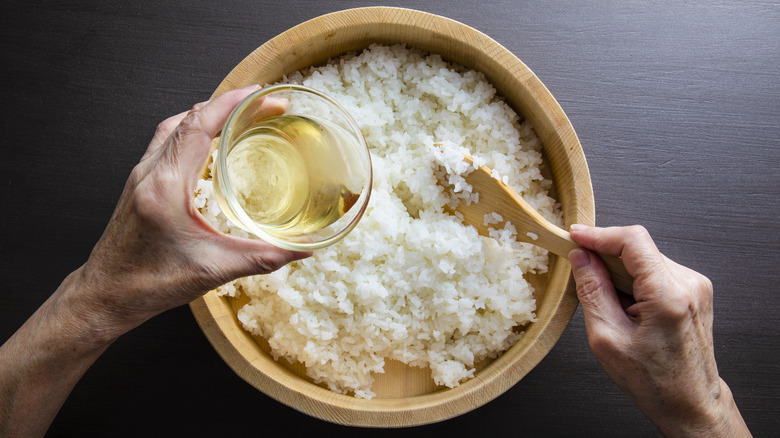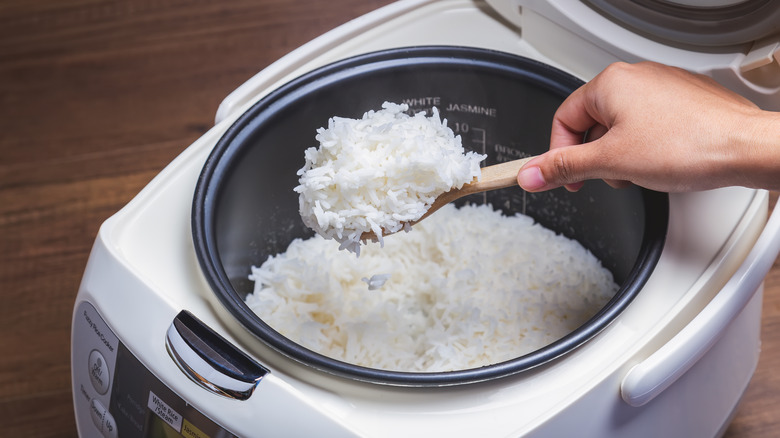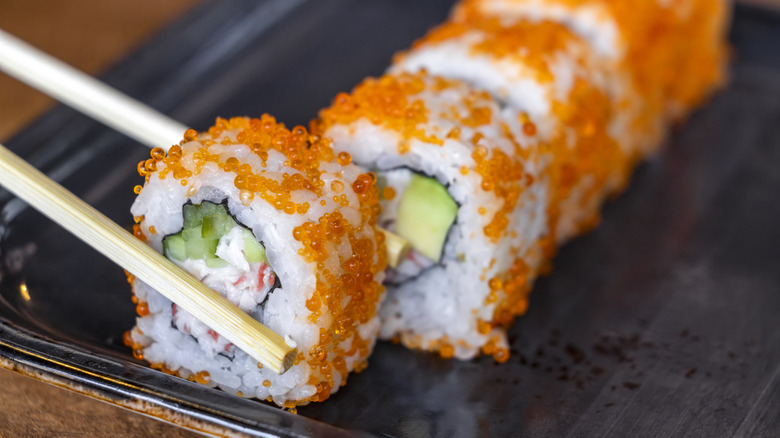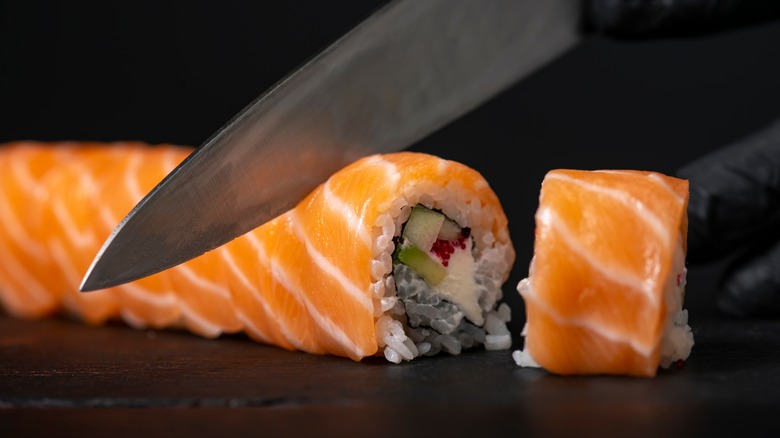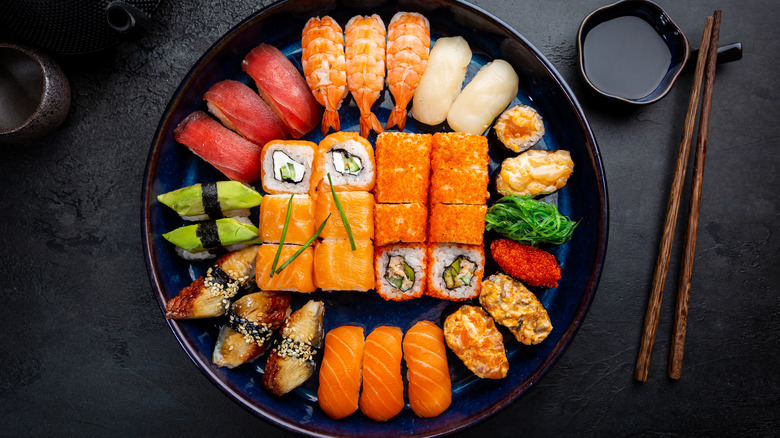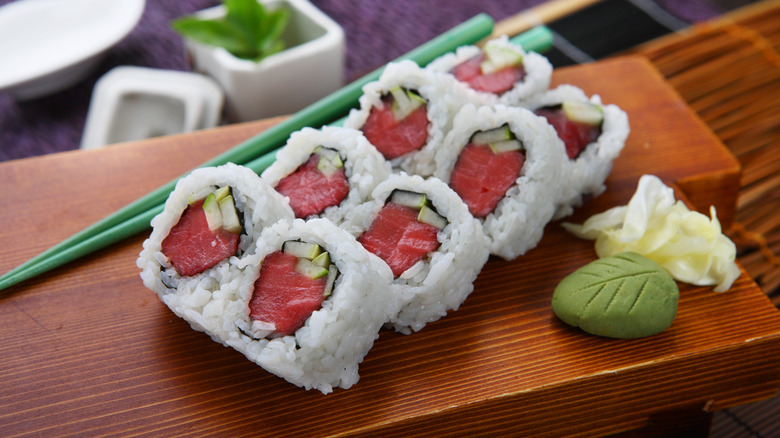9 Tips You Need To Know When Making Sushi At Home, According To An Expert
We may receive a commission on purchases made from links.
With its striking presentation and deliciously balanced flavors, sushi is one of those dishes that it's easy to develop a taste for. Traditional Japanese sushi is light yet satisfying and packed with protein and healthy fats, while Western sushi often incorporates additional flavors like creamy mayo and spicy sriracha. However, when it comes to making sushi at home, the preparation can feel intimidating. Cooking the rice to the perfect consistency, working with unfamiliar ingredients, making sure the rolls hold together — these things can unsettle even experienced home cooks.
To dispel these worries about homemade sushi, we interviewed Hugo Valdez, Culinary Director of Kinjo Enterprises, an Atlanta-based food group that includes Kinjo Room, Yakitori Kona, Flying Fish, and Bahn mi Station. Valdez is an expert in all things sushi-related and talked us through nine pro tips for making sushi at home — from making sure you have the right tools to selecting your fillings. Although there are a few very precise steps when making sushi, Valdez also stresses that you have a lot of flexibility. "In the end," he explains, "it's up to you on what you may like inside or outside of your rolls," so feel free to get creative.
1. Assemble your tools
Nothing is more aggravating than trying to make a new recipe only to realize you're missing vital preparation tools. Homemade sushi requires a few basic implements so it's a good idea to source these before you plan a big sushi dinner. Hugo Valdez explains that to make sushi at home you will need "a sharp knife, a sushi rolling mat, a chopping board, two kitchen towels," — one damp and one dry — and "plastic kitchen film" which helps with "forming rolls and aids in cutting them."
Your chopping board will be used for slicing your raw fish so a plastic board that's easy to wipe clean is optimal. However, if you want to use a wooden surface make sure it is thoroughly dry before use and that you deep clean it afterward — some of the biggest mistakes people make when cleaning a wood cutting board include putting it away wet and failing to deep clean regularly.
You may also want to consider buying a hangiri (also called a sushi oke). An oke is a wide wooden dish that lets you spread your cooked rice across a flat surface, allowing it to rest and cool before you make sushi rolls. A clean baking dish will also work for this. If you want to present your sushi traditionally, you can also buy serving crockeries, like chopsticks, porcelain sushi plates, and soy sauce dishes.
2. Select the right fish or filling
If you've eaten in sushi restaurants, you've probably noticed that the most common fillings are things like tuna, salmon, yellowtail (hamachi), and mackerel. Shellfish is also popular, with crustaceans like crab and shrimp cropping up on many sushi menus. Preparing sushi can be daunting for home cooks as it is important to understand which types of seafood are safe to consume raw. Eating raw fish can put you at risk of catching parasites and infections, which is why sushi restaurants serve sushi-grade fish — seafood that is frozen immediately after being caught.
If you're unsure, Hugo Valdez notes that "tuna and salmon are previously frozen" and are, therefore, "ok to use." Farmed tuna and salmon are also raised in controlled environments, reducing parasite risk. Buying local, freshly caught fish also generally raises the quality. When buying your fish, Valdez suggests asking "your local fish monger or instore fish expert at the counter where the fish comes from."
You can also ask when the fish was caught and "ask the clerk to place it with ice so you keep it as cold as possible on your trek home." Remember, you shouldn't judge salmon's quality on its color alone – the fish should also smell salty and have firm flesh that is not slimy. If you're not the biggest seafood fan, you can make sushi with beef, crunchy cucumber, avocado, or tamago nigiri (egg omelets).
3. Make sure you have a sharp knife
Hugo Valdez states that, when making sushi, "the most important part of your mise en place [is] your knife." Top-end Japanese sushi knives are well-known for being expensive as making restaurant-level sushi involves extremely precise cuts. Valdez stresses that you don't need to splash out on a premium knife to make sushi at home and that mid-price brands like DEXTER and VICTORINOX are perfectly suitable.
One thing that Valdez does insist on is that your knife must be sharp. Not only can dull or blunt blades tear fish and meat — preventing you from getting the nice, clean slabs associated with sushi — but they can also be dangerous. Cutting with a blunt knife forces you to press harder. This makes the knife more likely to slip and increases your risk of cutting yourself.
If you're used to handling knives, you can use an at-home knife sharpener to spruce up your blade. If you don't have a knife block at home, Valdez recommends finding "a local sharpener to have them give your knife a little love." Chopping your protein while still chilled is one hack that makes slicing meat easier and this also goes for fish. Valdez also emphasizes using a knife that feels comfortable in your hand.
4. Choose the right kind of rice
Alongside your chosen filling and your seaweed nori sheets, rice is the third essential component you'll need for making a traditional sushi spread. Sushi translates to sour rice in Japanese, indicating that rice is integral to the dish. Choosing the right rice is crucial as not all rice grains will create that sticky yet fluffy texture you need for sushi rolls. Japanese short-grain rice has high starch levels, which gives it a glutinous feel and allows it to bind into moldable shapes. Hugo Valdez states his preference for TAMAKI Gold short-grain rice and recommends "washing the rice a minimum of three times in a strainer under cold water" before cooking to remove excess starch, which can give your sushi a chewy texture.
Once you've made your rice, season it with vinegar — the secret ingredient that makes rice fluffier than ever. Aim to stir in around 200 milliliters of rice vinegar for every kilogram of your cooked rice, along with a dash of white sugar and salt. Alternatively, you can use store-bought sushi seasoning, which already contains salt and sugar.
5. Use a rice cooker
According to Hugo Valdez, sushi rice is a food you should try making in your rice cooker if you have one at home. Using a rice cooker lets you set the exact ratios of rice to water, making the correct measurements easier to achieve. Valdez explains that "a 1:1 ratio (rice to water) will ensure your rice is not mushy but soft, yet firm enough for you to mix your sushi vinegar."
This means for every cup of rice you add, you should also add a cup or equivalent measure of water. You can also use the rice cooker basin to hold your rice until you're ready to use it.
If you haven't got a rice cooker, you can make sushi rice on the stovetop in a pan. The ratios can be a little less predictable doing it this way but you can opt for a one-to-one ratio of rice to water, or play it slightly safer with two parts rice to three parts water. Add your rinsed rice to the pot and pour in the water, then cover with a lid and let the water come to a boil. Without removing the lid, turn your rice down to a simmer and allow it to cook for around 15-20 minutes or until all the water is absorbed.
6. Make sure you get the temperatures right
While sushi is often thought of as a cold dish, Hugo Valdez stresses that "this could not be further from the truth." While your fish should be kept cold before preparation, sushi is generally eaten at room temperature, with the fish served slightly cooler than the rice. The fish should not be fully chilled when your sushi is served as this will reduce its natural flavors. Sushi rice is also easier for chefs to handle when it is around body temperature as it will keep its shape better.
Temperature is also important during your sushi storage and preparation. The rice must not be too hot or cold when you stir in your sushi vinegar as this can make your rice too sour, by absorbing too much vinegar, or too bland, by not absorbing enough. If you have any leftover rice or want to let it sit for a couple of hours before making your sushi, don't put it in the refrigerator.
Chilling the rice will dry it out, making it difficult to shape plus it will be hard and unpleasant to eat. Instead, you can cover your rice with a cool, damp cloth to help it stay fresh.
7. Dampen your knife
So, you've made it this far. You've got your stunning sushi rice and your carefully selected fish and you've managed to bind it into a perfect roll using your kitchen film and rolling mat. You may think the work is over, but Hugo Valdez assures us that there is another important step — slicing your sushi roll into bitesize pieces to serve.
Make sure your cutting board or sushi rolling mat is completely dry when you assemble your rolls. "Moisture," Valdez says, "is both your friend and foe when making sushi." While a damp chopping board can rip your delicate nori sheets or make them soggy and difficult to work with, using a slightly moist knife will help you cut cleanly through your sushi roll. "A simple wipe with a damp towel will take care of this," Valdez says, and will also help clean your knife between cuts, ensuring that nothing sticks to it.
8. Opt for classic combos
While there is no correct sushi filling, Hugo Valdez notes that "traditional pairings [such as] shrimp and avocado rolls, California rolls, scorpion rolls, or spicy scallop rolls" are a good starting point. California rolls usually combine crab meat with cucumber, avocado, and mayonnaise, while scorpion rolls are often filled with a crab and avocado combo and topped with shrimp or tuna.
For a simple and classic sushi roll, Valdez recommends combining "salmon, cucumber, and thinly sliced avocado, wasabi mayo, crunchy fried garlic, sesame seed, [and] lemon." If you want to mix things up and get out of your comfort zone try a "spicy albacore or yellow tail filling, thinly sliced salmon on top, avocado, spicy mayo, sesame seeds" and perch some avocado and spicy eel sauce on top.
Other delicious sushi pairings include a Philadelphia roll – smoked salmon, cream cheese, and cucumber — and a spicy tuna roll that blends raw tuna with sriracha, chili mayonnaise, and sesame oil. If you're making nigiri, the most common method is to drape cuts of raw salmon, tuna, or butterfly-sliced shrimp over rice. Tofu sushi is also a great choice for vegetarians. You can marinate the tofu to give it some extra bite and flavor.
9. Serve with flavor-enhancing side dished and toppings
One of the best things about sushi is the side dishes and toppings that traditionally accompany and enhance this tasty meal. Hugo Valdez notes that you should have the "usual suspects" — that is "ginger, wasabi, and soy sauce" — on your table. Pickled ginger is traditionally served with sushi and can be bought in jars from most Asian shops and grocery stores.
Valdez also advises diners to go easy with the soy sauce as the strong salty flavor can easily "overpower your meal by ruining your palate." Choose a low-sodium option if possible and serve it in a side dish so that you can dip your sushi rather than pour the sauce on top. The third classic condiment, wasabi paste, is also easy to find in stores like Kroger and Walmart. Don't stress trying to find authentic wasabi as this comes with a hefty price tag — if you're wondering why real wasabi is so expensive, it's made using rare Japanese horseradish that is difficult to grow outside of Asia.
Storebought wasabi, meanwhile, is made from European horseradish and mustard flour. If you've never had wasabi before, remember to start with a small amount as the strong, spicy flavor can cause an intense burn that notoriously goes right up your nose. Other sides, like edamame beans and miso broth, are also common sushi accompaniments.
